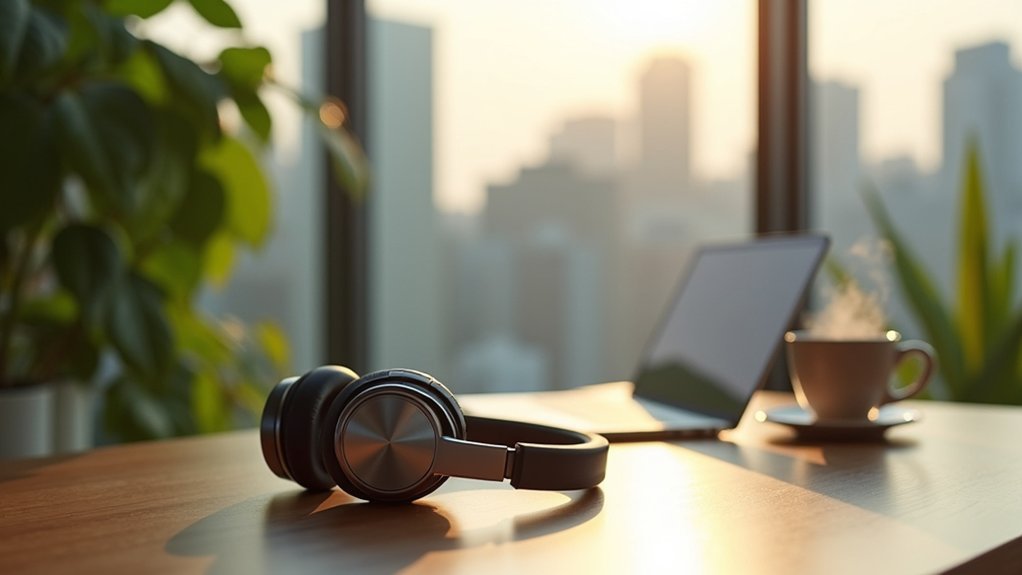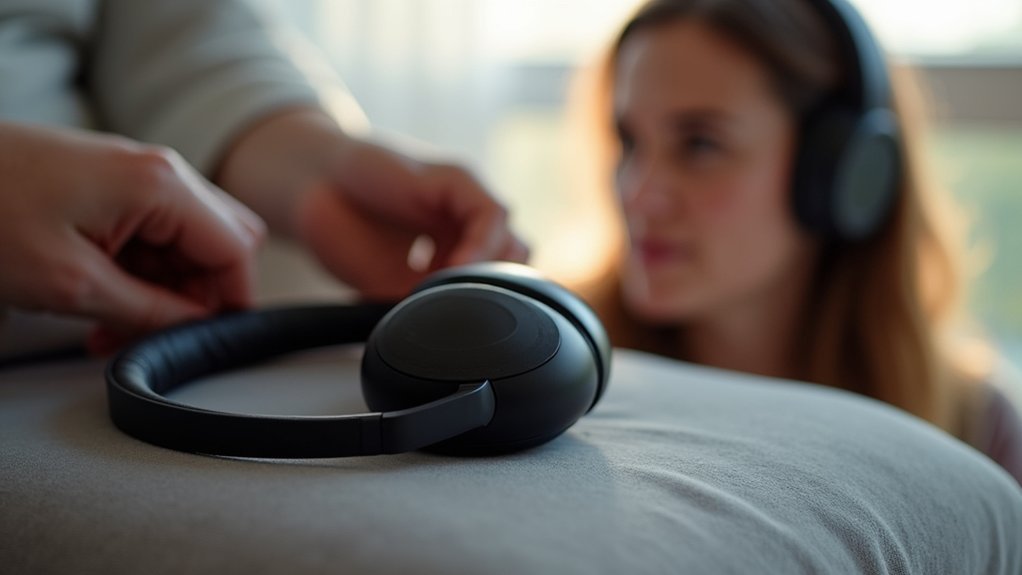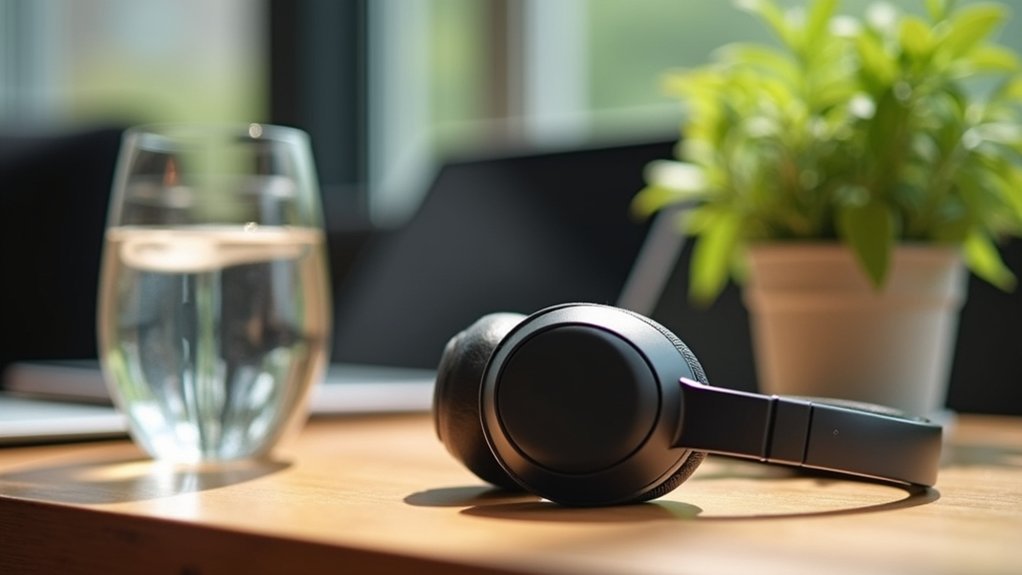To achieve crystal clear wireless headset audio, you’ll need to master five key areas. First, choose headsets with active noise cancellation (ANC) that counters low-frequency background sounds. Second, maintain your Bluetooth connection by staying within 33 feet, updating firmware, and minimizing interference. Third, guarantee proper fit with adjustable headbands and cushioned ear cups. Fourth, configure your equalizer to emphasize mid-range frequencies while reducing bass and treble. Finally, clean your headset weekly and test battery performance monthly. These optimization techniques will transform your audio experience entirely.
Choose the Right Noise-Cancelling Technology for Your Environment

When selecting a wireless headset, you’ll want to prioritize Active Noise Cancellation (ANC) technology if you work in noisy environments. This noise-cancelling technology uses built-in microphones to detect and counteract background noise, ensuring clear communication during calls.
High-quality noise-cancelling headsets offer flexibility by allowing you to adjust cancellation levels based on your specific environment. ANC works most effectively against low-frequency sounds like air conditioning hums or office chatter.
Consider your workplace when choosing the right system. Busy professional settings like call centers require stronger noise cancellation than quieter spaces.
The right headset delivers crystal-clear audio, reducing distractions and boosting productivity. You’ll experience smoother conversations and enhanced focus, making these headsets essential for maintaining professional communication standards in challenging acoustic environments.
Optimize Your Bluetooth Connection and Device Compatibility
While selecting the perfect wireless headset is essential, enhancing your Bluetooth connection guarantees you’ll actually experience the performance you paid for.
Start by ensuring your Bluetooth headsets are fully charged and positioned within the 33-foot wireless range for stable connection maintenance.
Check compatibility across your devices—while most support Windows, macOS, iOS, and Android, specific audio technology features vary.
Device compatibility extends beyond basic connection—specific audio features and performance capabilities differ significantly between operating systems.
Update firmware on both your headset and connected devices to prevent connectivity issues and access peak performance.
Minimize interference by reducing active Bluetooth connections and keeping headsets away from microwaves and Wi-Fi routers.
When experiencing persistent problems, perform a Bluetooth reset by unpairing and re-pairing devices.
These simple steps maximize your noise canceling headset’s potential.
Ensure Proper Fit and Comfort for Extended Use

Having refined your Bluetooth connection, you’ll want to focus on achieving the perfect fit to maximize comfort during those marathon work sessions. Proper fit prevents ear fatigue and guarantees prolonged use without discomfort.
You’ll need adjustable headbands and cushioned ear cups that conform to your head shape. Ergonomic designs greatly improve wearability, while lightweight construction reduces neck strain during extended calls.
| Comfort Feature | Benefit |
|---|---|
| Adjustable headbands | Customized fit for any head size |
| Cushioned ear cups | Reduces pressure points and soreness |
| Lightweight design | Minimizes fatigue during long sessions |
Test different ear tip sizes to achieve ideal sound isolation and audio quality. A proper seal enhances both comfort and performance, making your wireless headset more effective for professional use.
Configure Audio Settings and Equalizer for Maximum Clarity
Once you’ve secured a comfortable fit, optimizing your headset’s audio settings becomes essential for crystal-clear communication. Fine-tuning your frequency response and equalizer settings dramatically improves voice clarity during calls.
Configure these key audio settings:
- Adjust your equalizer to emphasize mid-range frequencies (300 Hz to 3 kHz) where human speech occurs, while reducing bass and treble that cause muddiness.
- Enable digital signal processing features and audio enhancements to minimize background noise and refine overall audio performance.
- Install firmware updates regularly since manufacturers release improvements that boost compatibility and crystal-clear calls.
Experiment with voice-specific equalizer presets on your device, as these optimize spoken audio quality.
Proper audio settings guarantee your headsets help deliver professional communication quality, transforming ordinary conversations into exceptionally clear exchanges that enhance productivity and reduce listener fatigue.
Maintain Your Headset for Consistent Performance

Proper maintenance determines whether your wireless headset delivers consistent, professional-quality performance over months and years of use. You’ll maintain peak sound quality by regularly cleaning ear cups and microphone areas to prevent audio degradation. Store your headset safely to avoid damage that compromises call quality and battery life.
Update your headset’s software frequently to access performance enhancements and bug fixes that improve overall audio clarity. Adjust noise cancellation levels based on your environment—higher settings work best in noisy spaces while lower levels suit quieter areas.
| Maintenance Task | Frequency | Impact on Performance |
|---|---|---|
| Clean ear cups/microphone | Weekly | Prevents sound degradation |
| Inspect cables for wear | Monthly | Maintains clear audio connection |
| Test battery performance | Monthly | Guarantees consistent wireless operation |
| Update software | As available | Maximizes audio and call quality |
Frequently Asked Questions
Why Is My Wireless Headset Dying so Fast?
You’re likely experiencing fast battery drain because you’re keeping volume too high, leaving noise cancellation on constantly, not fully powering down when finished, or your battery’s aging and losing capacity.
How to Take Care of Wireless Headsets?
You’ll extend your headset’s life by cleaning it regularly with soft cloths, storing it properly, updating firmware, charging periodically to maintain battery health, and avoiding extreme temperatures or moisture exposure.
What Wireless Headset Has the Best Mic Quality?
You’ll find the Bose 700 UC delivers exceptional mic quality with its six-microphone system. The Jabra Evolve2 85 and Sennheiser MB 660 UC also offer superior voice clarity for professional calls.
How Do I Get My Wireless Headset to Work?
Make certain your headset’s fully charged, then activate Bluetooth on your device. Hold the power button until it enters pairing mode, then select it from your device’s Bluetooth settings to connect.
In Summary
You’ve got all the tools you need to transform your wireless headset experience. By selecting proper noise-cancelling tech, optimizing your Bluetooth setup, ensuring a comfortable fit, fine-tuning your audio settings, and maintaining your device regularly, you’ll enjoy crystal clear sound every time. Don’t let poor audio quality hold you back—implement these five strategies today and you’ll notice an immediate difference in your listening experience.





Leave a Reply